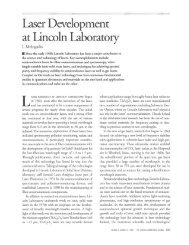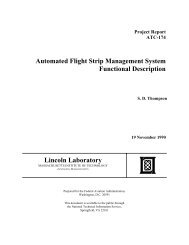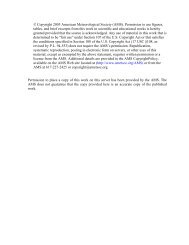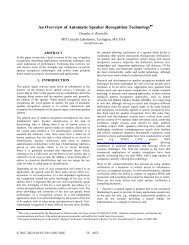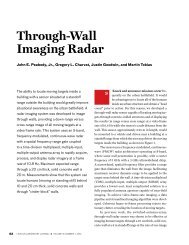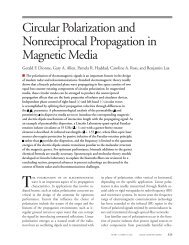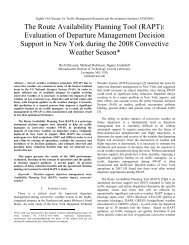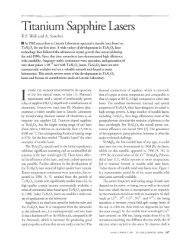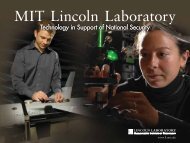2011 Annual Report - MIT Lincoln Laboratory
2011 Annual Report - MIT Lincoln Laboratory
2011 Annual Report - MIT Lincoln Laboratory
Create successful ePaper yourself
Turn your PDF publications into a flip-book with our unique Google optimized e-Paper software.
severity than previously reported for<br />
speech-rate measures.<br />
■ The high-data-rate military SATCOM<br />
waveform that the <strong>Laboratory</strong> developed<br />
and demonstrated for intelligence,<br />
surveillance, and reconnaissance (ISR)<br />
readout was provided to more than 25<br />
industry and government teams.<br />
■ Low-profile military SATCOM antennas<br />
for airborne applications were delivered<br />
to the <strong>Laboratory</strong> and flight tested.<br />
LEADERSHIP<br />
■ New technologies for net-centric operations<br />
include a framework that allows<br />
users to construct, share, and execute<br />
applications without programming and<br />
an architecture and prototype implementation<br />
that federates resource-brokering<br />
across mission areas.<br />
Dr. J. Scott Stadler Dr. Roy S. Bondurant Mr. Stephan B. Rejto Dr. Marc A. Zissman<br />
Jeffrey Hall of the Wideband Tactical Networking Group operates the Portable<br />
Army Communications-on-the-move Terminal Block 1 mobile SATCOM<br />
terminal that demonstrates the ability to have mobile communications that are<br />
robust to disruption by jamming or other attacks.<br />
FUTURE OUTLOOK<br />
One of the Advanced Multiband<br />
Communications Antenna Systems<br />
(AMCAS) is ready to undergo flight testing to<br />
demonstrate the viability of using low-profile<br />
antennas on widebody aircraft to achieve<br />
multi-Mbps communications via military<br />
satellite communications.<br />
■ Continued development of novel devices for optical communications will include a highefficiency<br />
single-photon source; a high-efficiency, small size, weight, and power, flexible<br />
frequency/time modulator; and multimode receiver.<br />
■ <strong>Lincoln</strong> <strong>Laboratory</strong>’s protected SATCOM terminals will continue to be used to control the<br />
nation’s protected SATCOM constellation and to provide post-launch calibration of the<br />
Advanced Extremely High Frequency (AEHF) satellites.<br />
■ Ground-based dynamic resource allocation concepts that dramatically increase the<br />
capacity of protected SATCOM systems will be demonstrated.<br />
■ The <strong>Laboratory</strong> will extend its work on machine translation and document analysis to<br />
enable effective cross-language search and information retrieval from foreign-language<br />
documents by analysts operating in English.<br />
■ A ground mobile terminal capable of connecting to the recently launched AEHF satellite<br />
will be completed and demonstrated. This vehicle also has real-time connection to<br />
a network emulation test bed that illustrates the effects and interactions of multiple<br />
terminals.<br />
<strong>MIT</strong> <strong>Lincoln</strong> <strong>Laboratory</strong> 31



